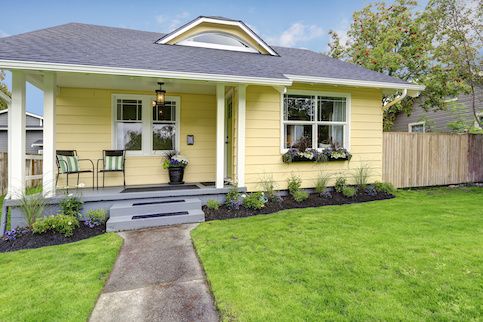What Is The Loan Principal In A Mortgage?

A mortgage is a huge investment, so it’s important to understand every aspect of your loan. Two of the most basic components of your loan that you should be aware of are principal and interest. As you likely know, interest compounds on your loan at an amount determined by your interest rate – but what is principal?
Let’s break down the details of what your loan principal is, how it factors into your monthly payments and how you can repay it faster.
What Is A Loan Principal?
Your loan principal is the total amount that you originally borrow when you get a mortgage. As you make your monthly mortgage payments, your mortgage lender or servicer allocates your payments to cover a certain percent of your principal as well as interest, homeowners insurance and property taxes.
While there are many different types of home loans, the way you pay on a mortgage doesn’t generally change. Over time, you’ll pay the principal of your loan until it’s paid off in full and you own the house. This typically happens over a period or loan “term” of 15 – 30 years, though you can get loans with shorter or longer terms depending on the mortgage type.
See What You Qualify For
Home Purchase
Home Refinance
Tap Into Equity
How Is A Mortgage Repaid?
You pay your mortgage in small chunks every month over a set period of years, usually 15 – 30 as we mentioned above. The size and term of your loan will determine how large your monthly payments are. With shorter term loans, your monthly payments will usually be higher.
For example, if you get a loan for a home that costs $250,000, your principal amount is $250,000. With a 15-year fixed mortgage and an interest rate of 3%, plus taxes and fees, your monthly payment might be around $2,143. With a 30-year fixed mortgage on the same house with the same interest rate, your monthly payment would be significantly lower – around $1,471.
Once you’ve completely paid off the principal of your loan, you no longer have to make mortgage payments and own the home free and clear.
What Is Included In My Monthly Mortgage Payment?
Your mortgage payment every month will consist of interest on your loan, principal (depending on the amount of interest that has been paid down), taxes and finally homeowners and/or mortgage insurance, which is often paid through an escrow account set aside by your lender or servicer.
You can remember the major things that are included in your payment with the acronym “PITI,” which stands for principal, interest, taxes and insurance. If you have a conventional loan and don’t make a down payment of at least 20%, you will also have to pay private mortgage insurance (PMI) every month until you build a certain amount of equity.
If you have an adjustable-rate mortgage, the amount you pay toward your mortgage each month may not always be the same because the interest rate will adjust after the loan’s introductory period. With a traditional fixed-rate mortgage, your monthly payment may only change if the amount you’re paying into escrow for taxes and insurance changes.
Over time, the portion of your payment that goes toward interest will shrink while the portion going towards principal will grow, but the total payment amount should remain the same.
See What You Qualify For
You can get a real, customizable mortgage solution based on your unique financial situation.
What Is Mortgage Amortization?
Mortgage amortization is the transition of your monthly payments from going mostly toward interest to going mostly toward the loan principal. As we explained above, the longer you pay on your loan, the more your payment will contribute to paying down the principal balance.
As you slowly pay down your principal, you are building home equity that will hopefully grow in market value over time. Equity is important because it helps you build wealth through the value of your home. This value can be cashed out if needed to fund home projects or consolidate debt.
If you’re currently paying on a mortgage, you can figure out your current home equity with our mortgage amortization calculator.
Are My Loan Principal Payments Tax-Deductible?
Repayment of your mortgage principal is not tax-deductible, but your interest payments might be. Thanks to some homeowner tax incentives, you can often deduct some or all your total yearly mortgage interest payments from your taxes.
For Individuals
If you have a loan to buy, build or improve a primary or second home, you can likely deduct interest paid on it. For mortgage loans issued from December 16, 2017, onward, homeowners can deduct up to $750,000 in paid interest. Mortgages older than that can still deduct up to $1 million, which was the previous limit before it was amended by the 2017 Tax Cut and Jobs Act. When you deduct your mortgage interest, you’ll generally do so using Form 1040 (Schedule A).
For Businesses
If you have a mortgage loan for a home that you use for business purposes, the rules for deducting interest are a little different, but there are still some benefits you may be able to claim. For example, if you own a home that you use as a rental property, you can likely claim depreciation on your taxes. Rental property depreciation allows you to claim depreciation on your property, granted it has a verifiable usable life, meaning it breaks down in quality or value over time.
If you use the property for a business that isn’t a rental property, you may be able to claim your mortgage interest as a business expense. You just need to make sure that it’s a business you operate yourself so that the interest can be claimed when itemizing profits and losses.
If you’re deducting interest as a business expense, you’ll likely have to fill out a Schedule C (Form 1040/1040-SR).
How Can I Repay My Loan Principal Faster?
You typically pay your principal off fairly slowly, since you have to take care of a sizable chunk of interest before your payments start making a dent in your loan balance. But what if you want to repay your principal faster? Repaying your loan more quickly can help you build equity and shorten your loan term, allowing you to build wealth and save on interest paid throughout the life of the loan.
So, how can you do it? Let’s talk about a few ways you can work toward paying off your mortgage early.
Biweekly Payments
No matter the size of your loan, your monthly mortgage payment is likely a little overwhelming. Principal, interest, taxes and insurance all at once can make for a hefty bill to pay every single month. One solution to make this payment more manageable (as well as help you pay more, faster) is to make biweekly mortgage payments rather than monthly ones.
If you typically pay $1,500 per month, switching to a biweekly schedule would mean that you would pay $750 every 2 weeks instead. Splitting up the payments can help make your budget more manageable, week by week – and switching to a biweekly schedule also means you’ll end up paying a little more than you would if you were just making monthly payments.
In a year, you’d generally make 12 payments on a monthly schedule. If you add up all the half payments you’d be making on a biweekly schedule, you’ll find that you actually end up making what equates to 13 full payments instead of 12 – which may not seem like much extra, but can actually take years off the life of your loan.
Mortgage Recast
When you make a large down payment at closing, you reduce the amount you’ll end up paying monthly throughout the life of your loan. What if you could do the same thing later on in your loan term?
You can do just that by doing a mortgage recast – also called mortgage reamortization. A mortgage recast allows you to pay a lump sum toward your loan’s principal balance, which decreases the cost of your monthly payments going forward.
Not everyone will be able to do this – loans through the Federal Housing Administration (FHA), Department of Veterans Affairs (VA), United States Department of Agriculture (USDA) and most jumbo loans are ineligible for mortgage recasting. Lenders will also have their own specific requirements about how much you can contribute and when.
If this is an option for you, however, and you have some money saved to put toward the loan, it can help you reduce the amount you still need to pay on your balance significantly.
Make Extra Payments
The one extra payment made when you pay biweekly rather than monthly can help you pay off your mortgage faster – so naturally, additional payments will compound on that. Some homeowners might choose to make a month and a half’s worth payment each month rather than their typical payment, which can help speed up the payoff time of their loan significantly.
If you can commit to making extra payments, it will reduce the amount of interest you’ll be paying over time, since you’d be shrinking the principal amount at an increased rate.
For example, let’s say you take out a fixed 30-year loan of $175,000 at 4% interest to purchase a house. Over the life of the loan, you can expect to pay $125,771.64 in interest. That’s almost the size of the principal balance of the loan itself!
If you paid an extra $100 every month on your mortgage payments, you could reduce that interest amount to a more manageable $99,650.33. That’s $26,121.31 in total savings – which is a significant amount.
Refinance Your 30-Year Term Into A 15-Year Mortgage
For those truly dedicated to achieving financial independence and paying off their loan as soon as possible, refinancing your mortgage to a shorter term is another way to pay down the principal much faster – though it will mean higher monthly payments.
If you refinance a 30-year loan to a 15-year loan, you can pay off the principal balance in half the time – but your payments will be significantly higher each month. If you can swing it financially, this is a great way to pay off your home ahead of time and get the stress of monthly mortgage payments out of the way for good.
It will save you a great deal on interest by transitioning to a shorter term, but refinancing comes with a lot of costs as well. Expect much higher monthly payments as well as miscellaneous costs associated with refinancing, such as the application fee, appraisal fee, title search fee, etc.
Loan Principal FAQs
What determines the interest charged on principal?
The interest on the principal balance of the loan is determined by your credit score and credit history. Keep in mind that loan type, loan term and in some cases the property location and down payment can also be contributing factors.
How do you calculate loan principal?
In order to calculate the loan principal on your loan, subtract your down payment from the home’s selling price. This number is your loan principal.
What are the benefits of repaying your loan faster?
If you’re looking to repay your loan quicker, it can benefit you financially. Not only will it help you build equity and shorten your loan term but it will allow you to build wealth and save on interest.
Can I make principal-only mortgage payments?
Principal-only payments are allowed as long as you’re still paying your full monthly mortgage payment. It’s important to indicate that you’d like a certain amount of money to go towards the principal of the loan when making principal-only payments.
The Bottom Line: Understand What Loan Principal Means For You
Your loan principal is the total amount that you originally borrowed to purchase your home – and to own your home free and clear, you must pay it off plus interest. This can be a very costly and time consuming endeavor. Luckily, there are plenty of ways to pay down your principal faster if you have the means to do so.
to make a confident offer and close on your loan faster.
See What You Qualify For
You can get a real, customizable mortgage solution based on your unique financial situation.











